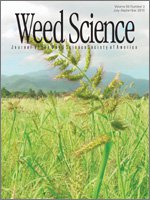A 50-yr study at Fairbanks, AK, was started in 1984 to determine soil seed longevity of 17 weed species. Seeds were buried in mesh bags 2- and 15-cm deep and were recovered 0.7, 1.7, 2.7, 3.7, 4.7, 6.7, 9.7, 19.7, and 24.7 yr later. Viability was determined using germination and tetrazolium tests. By 24.7 yr after burial (YAB), no viable seeds were found for common hempnettle, flixweed, foxtail barley, quackgrass, and wild oat. Bluejoint reedgrass, which had no live seed 19.7 YAB, again had viability (1% at 15 cm) 24.7 YAB. Seeds of 11 other species were still viable: American dragonhead (52%), marsh yellowcress (11 and 3.0% at 2 and 15 cm respectively), common lambsquarters (2.8%), prostrate knotweed (2.8% at 15 cm), shepherd's-purse (2.8%), pineapple-weed (2.6%), rough cinquefoil (2.3%), Pennsylvania smartweed (1.1%), common chickweed (0.4%), wild buckwheat (0.3%), and corn spurry (0.1%). Seed dormancy 24.7 YAB was very low (< 10%) for all species except American dragonhead (99%), shepherd's-purse (40%), marsh yellowcress (23% at 2 cm), Pennsylvania smartweed (18%), and rough cinquefoil (14%). At the beginning of the study, declines in seed longevity were uniform between replicates, but variability between replicates increased over time for all species except American dragonhead, suggesting that some soil microsites are more favorable for seed survival and may be seedbank “safe sites.” Results of this study demonstrate that nonrandom seed mortality contributes to the spatial heterogeneity of seed populations in the soil seedbank.
Nomenclature: American dragonhead, Dracocephalum parviflorum Nutt. DRAPA; bluejoint reedgrass, Calamagrostis canadensis (Michx.) Beauv. CLMCD; common chickweed, Stellaria media (L.) Vill. STEME; common hempnettle, Galeopsis tetrahit L. GAETE; common lambsquarters, Chenopodium album L. CHEAL; corn spurry, Spergula arvensis L. SPRAR; flixweed, Descurainia sophia (L.) Webb. ex Prantl DESSO; foxtail barley, Hordeum jubatum L. HORJU; marsh yellowcress, Rorippa palustris (L.) Bess. RORIS (in previous manuscripts called Rorippa islandica (Oeder) Borbas); Pennsylvania smartweed, Polygonum pensylvanicum L. POLPY; pineapple-weed, Matricaria discoidea DC. MATMT (in previous manuscripts called Matricaria matricariodes (Less.) C.L. Porter); prostrate knotweed, Polygonum aviculare L. POLAV; quackgrass, Elymus repens (L.) Gould AGRRE (in previous manuscripts called Elytrigia repens (L.) Nevski); rough cinquefoil, Potentilla norvegica L. PTLNO; shepherd's-purse, Capsella bursa-pastoris (L.) Medik. CAPBP; wild buckwheat, Polygonum convolvulus L. POLCO; wild oat, Avena fatua L. AVEFA.





